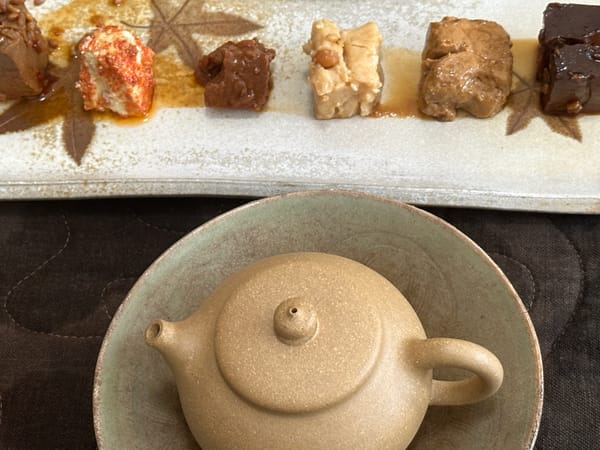On a cool, slow afternoon, I often find myself settled into an old rattan chair, with a warm pot of tea by my side and a small dish of dark-hued fermented tofu on the table. It’s a scene that brings me immense comfort—a simple ritual since childhood. But did you know? When aged fermented tofu meets ripe Pu’er tea, the experience becomes a rich, profound conversation between two old souls—layered, deep, and unforgettable.
Many tea lovers often ask: “What food pairs well with Pu’er?” Today, let’s explore this often-overlooked but extraordinary pairing.
Aged Fermented Tofu: The Art of Time in Eastern Fermentation
The Flavor Evolution of Fermented Tofu
Often dubbed the “cheese of the East,” fermented tofu is a familiar sight across Chinese households. Think of a morning bowl of rice porridge, paired with a cube of fermented tofu—simple, yet satisfying. But the most enchanting part? Its transformation over time.
After 3 to 5 years of aging, fermented tofu deepens in color and gains complexity. The fresh bean aroma gives way to a rich, savory sweetness, with hints of umami and a subtle lingering aftertaste. This layered transformation is the very soul of aged tofu.
Ripe Pu’er Tea: The Mature Journey of Yunnan Leaves
What is Ripe (Shou) Pu’er?
Ripe Pu’er is also a masterpiece of time. For newcomers to tea, “wo dui” (渥堆) refers to the accelerated fermentation process where tea leaves are piled up to 75cm, moistened, and covered in warm, humid conditions. After 42–45 days, the tea is no longer bitter or harsh—it becomes mellow, sweet, and earthy.
The Secret of Fermentation: Shared Soul of Tofu and Pu’er
Why Do They Pair So Well?
The answer lies in their shared essence—fermentation. These are two iconic Eastern fermented foods that, when combined, create a surprisingly harmonious duet.
Fermentation may sound scientific, but it’s part of daily life. It breaks down proteins into amino acids, unlocking flavor and making food easier to digest. Aged tofu becomes more savory, layered, and even digestively beneficial.
The Craft and History of Ripe Pu’er
The ripe Pu’er technique was pioneered and publicized by Mr. Lu Zhu-xun of Hong Kong’s Fuhua Tea House. His mastery of humidity and temperature turned raw bitterness into smooth sweetness, making ripe Pu’er approachable and beloved.
Aged Tofu × Ripe Pu’er: A Taste of Aged Resonance
When Savory Meets Sweet: The Flavor Dialogue
When dark, aged tofu (3–5 years) meets ripe Pu’er, it’s not just a flavor match—it’s a soulful reunion. Many are surprised by how well Pu’er complements tofu.
The tea brews a deep amber color, with warm notes of wood and dried fruit. A gentle sip lingers sweetly. Then comes the fermented tofu—its salty umami spreading across the tongue.
A Surprising Balance
What’s magical is how the saltiness of tofu and the mellow sweetness of Pu’er enhance each other. The tofu brings richness, while Pu’er softens and extends the flavor, creating a symphony of aged depth—like two wise elders exchanging meaningful stories at sunset.
Water Quality & Fermentation: The Quiet Connection
Good Water, Better Flavor
Water plays a crucial role in fermentation—both in tofu and tea. It’s an often-overlooked but foundational element.
Water in Pu’er Fermentation
In the wo dui process, water quality is vital. Chlorinated tap water disrupts fermentation. Spring or well water, rich in natural minerals, fosters proper microbial development—just as tofu makers in Shilin use deep well water for their famous blocks.
Water for Brewing Pu’er
When brewing Pu’er, soft water brings out the tea’s full body and aged sweetness. Pairing excellent water, well-brewed tea, and aged tofu creates a moment of everyday joy.
How to Enjoy Tofu × Pu’er: A Slow Tasting Ritual
- Choose Well-Aged Tofu: Go for 3–5 year aged varieties with darker color and richer taste. Red yeast tofu is a gentle starting point.
- Brew Ripe Pu’er Properly: Use water around 95°C. Rinse leaves for 3–5 seconds, then steep 20–30 seconds, adjusting to taste.
- Sip, Then Bite: Start with a sip of tea, then a bite of tofu. Let the flavors merge and unfold.
- Focus Fully: Turn off your phone, quiet your mind, and savor each moment. This is more than a meal—it’s a meditation.
Slow Food in a Fast World: The Healing Power of Fermentation
Aged Foods, Modern Comfort
In a world of rush and noise, sitting with a bite of aged tofu and a cup of ripe Pu’er is grounding. It soothes not just the palate—but the soul.
The Philosophy Behind the Pairing
This pairing honors slowness. It teaches us to value what takes time to mature. Just like aged tofu or Pu’er, some things are best revealed with patience.
A Taste of Presence
Next time you're overwhelmed, brew a pot of Pu’er, plate some aged tofu, and let the moment unfold. This ritual, simple yet profound, may be the most nourishing part of your day.
Conclusion: A Time-Honored Fermentation Dialogue
A Perfect Meeting of Two Aged Treasures
Aged fermented tofu and ripe Pu’er tea—both shaped by time—come together to form a rich, cultural and sensory symphony.
The Gift of Time
As we savor their depth, we’re reminded that life’s most beautiful flavors often come from waiting, aging, and tasting slowly.
From Food to Philosophy
This isn’t just a flavor pairing—it’s a way of living. One cup, one bite, one quiet moment.
This is the dialogue of aging.
A sensory journey through time.
A meditation on fermentation.
A celebration of the slow.


